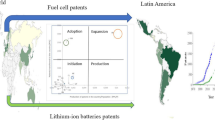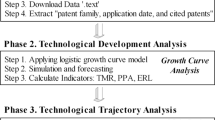Abstract
Technological trajectory is a representation of the development of technology. Based on the analysis of the trajectories of prominent technologies, we can explore the phenomena of technology evolution and knowledge diffusion. In this study, we focus on explaining knowledge diffusion in the core technology used in fuel cells, i.e. the development of 5-layer membrane electrode assembly (MEA) technologies. Through an investigation of path analysis, this study explores how the knowledge of this technology has evolved and diffused across different locations. The empirical analysis also explains how certain technological knowledge plays a critical role in main path. In this study, patent data of 5-layer MEA technologies for fuel cells is collected from the US Patent Office, for a total of 1,356 patents, followed by constructing a patent citation network based on citation relationships, recognising prominent patents with many citations through path analysis. Using the local main path analysis and global key-route method, we identify three stages of technological development, including an improvement of the proton exchange membrane (PEM) and catalyst synthesis. Additionally, we use regression analysis to demonstrate that patents with specific characteristics play a vital role in the process of knowledge diffusion. Patents from Japan and South Korea are relatively more important than patents from other countries. The brokerage characteristics of a patent (e.g., coordinating domestically or liaising among three or more countries) also facilitate the diffusion of technological knowledge. However, the importance of these brokerages changes when we look at inventing time. Furthermore, the technological diversification of a patent exerted no substantial influence on its network position.












Similar content being viewed by others
Notes
PEMFC: proton exchange membrane fuel cell; DMFC: direct methanol fuel cell; PAFC: phosphoric acid fuel cell; SOFC: solid oxide fuel cell; MCFC: molten carbonate fuel cell; AFC: alkaline fuel cell.
References
Aalbers, R., Koppius, O., Dolfsma, W. (2006). On and off the beaten path: Transferring knowledge through formal and informal networks, CIRCLE Electronic Working Papers.
Appleby, A. J., & Foulkes, F. R. (1988). Fuel cell handbook. New York: Van Nostrand Reinhold.
Batagelj, V. (2003). Efficient algorithms for citation network analysis, University of Ljubljana. Preprint Series, 41, 897.
Borgatti, S. P., Everett, M. G., & Freeman, L. C. (2002). Ucinet for windows: Software for social network analysis, Harvard Analytic Technologies.
Breschi, S., & Lissoni, F. (2009). Mobility of skilled workers and co-invention networks: an anatomy of localized knowledge flows. Journal of Economic Geography, Oxford University Press, 9(4), 439–468.
Britton, J. N. H. (2003). Network structure of an industrial cluster: Electronics in Toronto. Environment and Planning A, 35(6), 983–1006.
Burt, R. S. (1995). Structural holes: The social structure of competition. Cambridge: Harvard University Press.
Burt, R. S. (2005). Brokerage and closure: An introduction to social capital. Oxford: Oxford University Press.
Cantwell, J., & Iammarino, S. (2003). Geographical hierarchies European Union. In John Cantwell, Simon Iammarino, & Multinational Regional (Eds.), Systems of innovation (pp. 46–60). London: Routledge.
Delgado, M., Porter, M. E., & Stern, S. (2012), Clusters, convergence, and economic performance, NBER Working paper No. 18250.
Dosi, G. (1982). Technological paradigms and technological trajectories: A suggested interpretation of the determinants and directions of technical change. Research Policy, 11(3), 147–162.
Fernande, R. M., & Gould, R. V. (1994). A dilemma of state power: Brokerage and influence in the national health policy domain. American Journal of Sociology, 99(6), 1455–1491.
Garmaise, M. J., & Moskowitz, T. J. (2003). Informal financial networks: Theory and evidence. The Review of Financial Studies, 16(4), 1007–1040.
Giuliani, E., & Bell, M. (2005). The micro-determinants of meso-level learning and innovation: Evidence from a Chilean wine cluster. Research Policy, 34(1), 47–68.
Gould, R. V., & Fernandez, R. M. (1989). Structures of mediation: A formal approach to brokerage in transaction networks. Sociological Methodology, 19, 89–126.
Granovetter, M. S. (1973). The strength of weak ties. American Journal of Sociology, 78, 1360–1380.
Ho, M. H. C., & Liu, J. S. (2013). The motivations for knowledge transfer across borders: The diffusion of data envelopment analysis (DEA) methodology. Scientometrics, 94(1), 397–421.
Ho, M. H. C., & Verspagen, B. (2006). The role of national borders and regions in knowledge flows. In E. H. Lorenz & B. Å. Lundvall (Eds.), How Europe’s economies learn (pp. 50–73). New York: Oxford University Press Inc.
Hummon, N. P., & Dereian, P. (1989). Connectivity in a citation network: The development of DNA theory. Social Networks, 11, 39–63.
Jaffe, A. B., Trajtenberg, M. (1996). Flows of knowledge from universities and federal labs: Modeling the flow of patent citations over time and across institutional and geographic boundaries, NBER Working Papers 5712, National Bureau of Economic Research, Inc.
Jaffe, A. B., Trajtenberg, M., & Henderson, R. (1993). Geographic localization of knowledge spillovers as evidenced by patent citations. The Quarterly Journal of Economics, 108, 577–598.
Jaffe, A. B., Trajtenberg, M., & Fogarty, M. S. (2000), The meaning of patent citations: Report on the Nber/Case-western reserve survey of patentees, NBER Working Paper 7631.
Kordesch, K., Simader, G., & Wiley, J. (1996). Fuel cells and their applications. Weinheim: VCH.
Larminie, J., & Dicks, A. (2003). Fuel cell systems explained (2nd ed.). England: John Wiley & Sons Inc.
Lissoni, F. (2010). Academic inventors as brokers. Research Policy, 39(7), 843–857.
Litster, S., & McLean, G. (2004). Pem fuel cell electrodes. Journal of Power Sources, 130, 61–76.
Liu, J. S., & Lu, L. Y. Y. (2012). An integrated approach for the main path analysis: The development of the hirsch index as an example. Journal of the American Society for Information Science and Technology, 63(3), 528–542.
Liu, J. S., Lu, L. Y. Y., Lu, W. M., & Lin, B. J. Y. (2013). Data envelopment analysis 1978–2010: A citation-based literature survey. Omega-The International Journal of Management Science, 41(1), 3–15.
Maurseth, P. B., & Verspagen, B. (2002). Knowledge spillovers in Europe: A patent citations analysis. Scandinavian Journal of Economics, 104(4), 531–545.
Mehta, V., & Cooper, J. S. (2003). Review and analysis of pem fuel cell design and manufacturing. Journal of Power Sources, 114, 32–53.
Nooy, W., Mrvar, A., & Batagelj, V. (2005). Exploratory social network analysis with pajek. New York: Cambridge University.
Verspagen, B. (1998). European ‘regional clubs’: Do they exist, and where are they heading? On economic and technological differences between European regions. In J. Adams & F. Pigliaru (Eds.), Economic changes and growth (pp. 236–256), UK: Edward Elgar.
Verspagen, B. (2006). University research intellectual property rights and European innovation systems. Journal of Economic Surveys, 20, 607–663.
Verspagen, B. (2010). The spatial hierarchy of technological change and economic development in Europe. Annual Regional Science, 45, 109–132.
Verspagen, B., & Schoenmakers, W. (2004). The spatial dimension of patenting by multinational firms in Europe. Journal of Economic Geography, 4, 23–42.
Walker, G., Kogut, B., & Shan, W. (1997). Social capital, structural holes and the formation of an industry network. Organization Science, 8(2), 109–125.
Acknowledgments
The authors would like to thank two anonymous reviewers for their insightful comments that have improved the accuracy and readability of this paper. This study is partially supported by Taiwan’s National Science Council grants: NSC102-2410-H-011-009 and NSC102-2410-H-011-008-MY3.
Author information
Authors and Affiliations
Corresponding author
Appendix
Rights and permissions
About this article
Cite this article
Ho, M.HC., Lin, V.H. & Liu, J.S. Exploring knowledge diffusion among nations: a study of core technologies in fuel cells. Scientometrics 100, 149–171 (2014). https://doi.org/10.1007/s11192-014-1265-z
Received:
Published:
Issue Date:
DOI: https://doi.org/10.1007/s11192-014-1265-z




